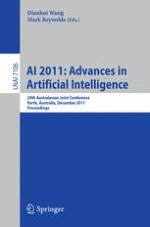This book constitutes the refereed proceedings of the 24th Australasian Joint Conference on Artificial Intelligence, AI 2011, held in Perth, Australia, in December 2011. The 82 revised full papers presented were carefully reviewed and selected from 193 submissions. The papers are organized in topical sections on data mining and knowledge discovery, machine learning, evolutionary computation and optimization, intelligent agent systems, logic and reasoning, vision and graphics, image processing, natural language processing, cognitive modeling and simulation technology, and AI applications.
